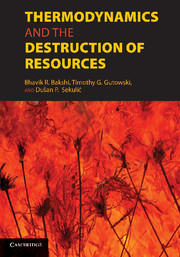Book contents
- Frontmatter
- Contents
- Contributor List
- Foreword by Herman E. Daly
- Foreword by Jan Szargut
- Preface
- Introduction
- PART I FOUNDATIONS
- PART II PRODUCTS AND PROCESSES
- PART III LIFE-CYCLE ASSESSMENTS AND METRICS
- 9 Using Thermodynamics and Statistics to Improve the Quality of Life-Cycle Inventory Data
- 10 Developing Sustainable Technology: Metrics From Thermodynamics
- 11 Entropy Production and Resource Consumption in Life-Cycle Assessments
- 12 Exergy and Material Flow in Industrial and Ecological Systems
- 13 Synthesis of Material Flow Analysis and Input–Output Analysis
- PART IV ECONOMIC SYSTEMS, SOCIAL SYSTEMS, INDUSTRIAL SYSTEMS, AND ECOSYSTEMS
- Appendix: Standard Chemical Exergy
- Index
- References
11 - Entropy Production and Resource Consumption in Life-Cycle Assessments
Published online by Cambridge University Press: 01 June 2011
- Frontmatter
- Contents
- Contributor List
- Foreword by Herman E. Daly
- Foreword by Jan Szargut
- Preface
- Introduction
- PART I FOUNDATIONS
- PART II PRODUCTS AND PROCESSES
- PART III LIFE-CYCLE ASSESSMENTS AND METRICS
- 9 Using Thermodynamics and Statistics to Improve the Quality of Life-Cycle Inventory Data
- 10 Developing Sustainable Technology: Metrics From Thermodynamics
- 11 Entropy Production and Resource Consumption in Life-Cycle Assessments
- 12 Exergy and Material Flow in Industrial and Ecological Systems
- 13 Synthesis of Material Flow Analysis and Input–Output Analysis
- PART IV ECONOMIC SYSTEMS, SOCIAL SYSTEMS, INDUSTRIAL SYSTEMS, AND ECOSYSTEMS
- Appendix: Standard Chemical Exergy
- Index
- References
Summary
Measuring Resource Consumption
This book is all about thermodynamics and resources, the meaning of resources, their interpretation in thermodynamics, their consumption, and the path to a sustainable way of managing resources. It has been clarified in other chapters that the consumption of resources is to be understood as a process of diminishing their usability. This is the basis for this chapter: understanding resource consumption as a loss of potential utility of these resources. The concept of potential utility is explained later in this chapter in more detail. For now it should suffice to note that consumption is only partly measurable in physical terms. We speak of consumption when the states of matter and energy change in a way that makes them less usable for human needs. Thus the general meaning of consumption has an anthropogenic notion, which cannot be evaluated in objective physical terms only. In some cases, this change in the usability of material or energy flows is accompanied by a proportional change in one or more of their physical properties, as, for example, when the temperature of a heat flow decreases. In these cases, measuring consumption is straightforward. In other cases, however, the changes in the material and energy flows are of a different nature with possibly no way of direct measurement. We might still be able to find changes in the physical, chemical, or biological properties of the flows that are responsible for the loss in usability, but the relation between consumption and the change in these properties is much more complicated.
- Type
- Chapter
- Information
- Thermodynamics and the Destruction of Resources , pp. 265 - 291Publisher: Cambridge University PressPrint publication year: 2011
References
- 2
- Cited by



